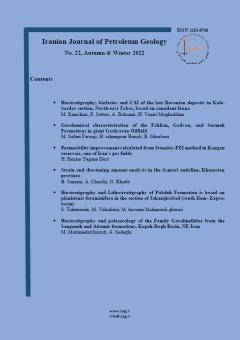Source rock characterization of the Fahlian, Gadvan, and Surmeh formations in giant Gachsaran oilfield
Subject Areas : GeochemistryMajid Safaei-Farouji 1 , Hossain Rahimpour-Bonab 2 , Buyuk Ghorbani 3
1 - University of Tehran
2 - University of Tehran
3 - پژوهشگاه صنعت نفت
Keywords: Source rock, Fahlian, Gadvan, Surmeh, hydrocarbon generation potential,
Abstract :
The aim of this study is geochemical evaluation of the Fahlian, Gadvan, and Surmeh formations as possible source rocks in Gachsaran oil field using Rock-Eval Pyrolysis manner. All of the studied samples possess migration index amounts lower than 1.5 showing indigenous nature of their hydrocarbons. TOC versus S2 and TOC against S1+S2 diagrams suggest fair hydrocarbon generation potential for the Fahlian and Surmeh formations and fair to good potential for the Gadvan formation. for the Fahlian and Surmeh formations type III kerogen and for the Gadvan formation mixed type II and II-III kerogens were identified. So, the Fahlian and Surmeh formations contain organic matter with terrigenous source (gas prone) and the Gadvan Formation possess both of marine and terrigenous organic matter (oil and gas prone). According to the cross plot of Tmax versus Hydrogen index (HI), the Gurpi formation is capable of mixed gas and oil, and gas generation and the Fahlian and Surmeh formations considered only gas prone formations. In terms of organic facies type, the surmeh, Fahlian, and Gurpi formations located in CD, C and CD, and BC and C zones of jones diagram, respectively. So, the Gadvan formation in compare to the Fahlian formation and the Fahlian formation in compare to the Surmeh formation, deposited under more anoxic conditions. In terms of thermal maturity, All of the Fahlian, Gadvan, and Surmeh formations located in oil window zone, but the Surmeh formation possess higher maturity than the Fahlian formation and the Fahlian formation have highr maturity in compare to the Gadvan formation.
مقاله: زینل زاده ا.، معین پور م.، شایسته م.، حیدری فرد م.، 1389، مدل سازی دوبعدی سیستم هیدروکربوری میادین گچساران و بی بی حکیمه، مجله پژوهش های چینه نگاری و رسوب شناسی، سال بیست و ششم، شماره پیاپی 41، شماره چهارم، صفحات 111 تا 124.
Alavi, M., 2004. Regional stratigraphy of the Zagros fold-thrust belt of Iran and its proforeland evolution. Am. J. Sci. 304(1), 1–20.
Tissot and Welte., 1978. . Petroleum Formation and Occurrence: A New Approach to Oil and Gas Exploration., Springer-Verlag.
Dembicki, H., 2016. Practical petroleum geochemistry for exploration and production. Elsevier
Dembicki Jr, H., 2009. Three common source rock evaluation errors made by geologists during prospect or play appraisals. Am. Assoc. Pet. Geol. Bull. 93, 341–356.
Espitalié, J., Laporte, J.L., Madec, M., Marquis, F., Leplat, P., Paulet, J., 1977. Méthode rapide de caractérisation des roches mères, de leur potential pétrolier et de leu degree d’évolution. Rev. l’Institut Français du Pétrole 32, 23–45.
Hakimi, M.H., Abdullah, W.H., Alqudah, M., Makeen, Y.M., Mustapha, K.A., 2016. Organic geochemical and petrographic characteristics of the oil shales in the Lajjun area, Central Jordan: Origin of organic matter input and preservation conditions. Fuel 181, 34–45.
Hunt, J.M., 1996. Petroleum geochemistry and geology. WH Freeman New York.
James, G.A., Wynd, J.G., 1965. Stratigraphic nomenclature of Iranian oil consortium agreement area. Am. Assoc. Pet. Geol. Bull. 49, 2182–2245.
Jones, R.., 1987. Organic Facies. In: Brooks, J., Welte, D. (Eds.), Advances in Petroleum Geochemistry. Acad. Press. New York 1–90.
Katz, B.J., Elrod, L.., 1983. Organic geochemistry of offshore California, Middle Miocene to Lower Pliocene strata. Geochim. Cosmochim. Acta 47, 389–396.
Maravelis, A.G., Chamilaki, E., Pasadakis, N., Zelilidis, A., Collins, W.J., 2017. Hydrocarbon generation potential of a Lower Permian sedimentary succession (Mount Agony Formation): Southern Sydney Basin, New South Wales, Southeast Australia. Int. J. Coal Geol. 183, 52–64.
Motiei, H., 1993. Stratigraphy of Zagros. Treatise Geol. Iran 60, 151.
Nairn, A.E.M., Alsharhan, A.., 1997. Sedimentary basins and petroleum geology of the Middle East, Elsevier.
Ola, P.S., Aidi, A.K., Bankole, O.., 2018. Clay mineral diagenesis and source rock assessment in the Bornu Basin, Nigeria: Implications for thermal maturity and source rock potential. Mar. Pet. Geol. 89, 653–664.
Peters, K.E., 1986. Guidelines for evaluating petroleum source rock using programmed pyrolysis. Am. Assoc. Pet. Geol. Bull. 70, 318–329.
Peters, K.E., Cassa, M.R., 1994. Applied source rock geochemistry: Chapter 5: Part II. Essential elements.
Peters, K.E., Moldowan, J.M., 1993. The biomarker guide: interpreting molecular fossils in petroleum and ancient sediments.
Setudehnia, A., 1978. The mesozoic sequence in southwest Iran and adjacent areas. J. Pet. Geol. 1, 3–42.
Sharland, P.R., 2001. Arabian Plate sequence stratigraphy, Gulf PetroLink, Manama, Bahrain.
Tissot, B., Durand, B., Espitalie, J., Combaz, A., 1974. Influence of the nature and diagenesis of organic matter in the formation of petroleum. Am. Assoc. Pet. Geol. Bull. 58, 499–506.
Tissot, B.P., Welte, D.H., 1984. Petroleum Formation and Occurrence, springer.
Van Buchem, F.S.P., Allan, T., Lausen, G.V., Lotfpour, M., Moallemi, A., Monibi, S., Motiei, H., Pickard, N., Tahmasbi, A.R.,
Vedrenne, V., Vincent, B., 2010. . Regional stratigraphic architecture and reservoir types of the Oligo-Miocene deposits in the Dezful Embayment (Asmari and Pabdeh Formations) SW Iran. GEOL. SOC. SPEC. PUBL, London 329, 219–263.
Yandoka, B.M.S., Abdullah, W.H., Abubakar, M.B., Hakimi, M.H., Jauro, A., Adegoke, A.K., 2016. Organic geochemical characterisation of shallow marine Cretaceous formations from Yola Sub-basin, Northern Benue Trough, NE Nigeria. J. African Earth Sci. 117, 235–251.
Ziegler, M.A., 2001, 2001. Late Permian to Holocene paleofacies evolution of the Arabian Plate and its hydrocarbon occurrences. GeoArabia 6 (3), 445–504.


